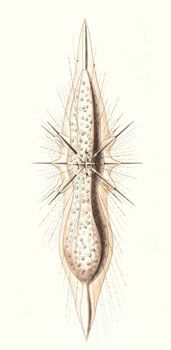Symphyacanthida
| Symphyacanthida | ||||||||||||
|---|---|---|---|---|---|---|---|---|---|---|---|---|

Amphibelone cultellata |
||||||||||||
| Systematics | ||||||||||||
|
||||||||||||
| Scientific name | ||||||||||||
| Symphyacanthida | ||||||||||||
| Schewiakoff , 1926 |
The Symphyacanthida are an order of unicellular , marine organisms from the group of Acantharia .
description
The skeletons of the Symphyacanthida have 20 spines. The cells are round to oblong. The tips of the spines are insoluble in sulfuric acid and fused into a small spherical or star-like mass in the center of the cell. The endoplasm has two layers. The inner layer contains the cell nuclei and is pigmented brown, yellow or reddish , the outer layer has anastomosing cytoplasmic processes and axopodial axonems .
The separating capsule wall is clearly visible under a light microscope and has a net-like shape. The ectoplasm is transparent. The periplasmic cortex can also be seen with a light microscope; it is shaped as an elastic lattice through whose numerous pores the axopodia protrude. The muonemes are flat. The gametogenesis takes place in a Gamontozyste instead.
Systematics
The order was first described by Vladimir Schewiakoff in 1926 , it contains three families with nine genera:
There are indications that the order is paraphyletic because the fusion of the spine attachments used as a diagnostic feature also occurs in other orders of the Acantharia.
There is no fossil record of the Symphyacantida.
proof
- ^ A b c Colette Febvre, Jean Febvre, Anthony Michaels: Acantharia In: John J. Lee, GF Leedale, P. Bradbury (eds.): An Illustrated Guide to the Protozoa . tape 2 . Allen, Lawrence 2000, ISBN 1-891276-23-9 , pp. 793 .
- ↑ a b palaeos.com: Palaeos Eukarya: Rhizaria: Acantharea , accessed January 7, 2012